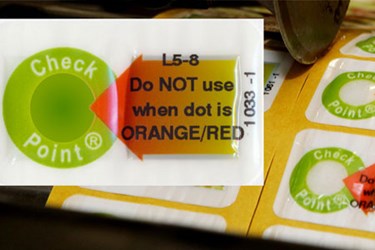New Technologies Offer Effective Monitoring Of Food Chain

By John Kalkowski, editor in chief, Food Online

For every challenge that food manufacturers face in processing and packaging, there is a way to automate, measure, or systematize a solution. And if it doesn’t already exist, some entrepreneur somewhere is probably working on it.
News of these innovations constantly flood into our offices. Some become commercial products; some fail to deliver the promised benefits. Each invention has, at its core, a potential answer to your problems. However, it’s easy to miss such product introductions.
To keep Food Online readers abreast of developments, I will try to periodically update you with brief descriptions of interesting technologies I see during plant tours or from information gleaned from press releases, blogs, or conferences/trade shows. These innovations may or may not work for you. Perhaps it’s an idea you may file away for future reference.
At the recent Food Safety Summit, several new products caught my attention. These might help companies address issues that arise with the upcoming implementation of new FSMA regulations. One major concern is whether or not food is maintained at the proper temperature to prevent bacterial growth as it is moved through the supply chain.
Indicators Tell Time, Temperature History
A number of companies have developed time/temperature indicators (TTIs), which provide a non-reversible record of a product’s temperature exposure. . One example is Vitsab (www.vitsab.com), which develops labels that can be affixed to a package to monitor time and temperature during shipping. These labels are customizable depending on the type of food being monitored. They use easily recognized “stop light” technology that transcends all languages. These TTI labels show the safety status of each package with a color indication; green means the shipment is safe, yellow means it is still safe if proper temperature is maintained, and red means stop and contact the supplier.
TTIs can rely on a variety of technologies, such as pouches with bacterial fluids that change color when certain time/temperature combinations have been reached or digital data loggers that record the temperature history of a product, identifying the time that out-of-tolerance temperatures were encountered. As supply chains lengthen and food safety regulations increase, TTIs are becoming an increasingly popular option for monitoring food safety.
Real-Time Reports Use GPS Technology
Some food companies may want to go a step further, using GPS technology to supply real-time data on the condition of their food shipments. Refrigerated shippers can fail due to numerous reasons, such as mechanical problems, human error, or lack of fuel. When that happens, entire truckloads of perishable foods may be dumped or sold as salvage. However, hidden damage may result in tainted foods that enter the retail and food service markets.
One company, GPS In A Box (www.gpsinabox.com), has developed a device that monitors truckloads and automatically reports product temperature, humidity, and door security alerts back to shippers in real time. It allows shippers to set custom high and low thresholds for temperatures. The system’s web-based platform monitors food loads and immediately sends alerts by text or email if it detects a variance from the individual product’s required specifications. GPS In A Box measures the pulp temperature of products without relying on the driver. The manufacturer claims pulp temperature is superior to air or ambient temperature, as it measures the actual temperature of the product, not just the air flowing over it. Using any Internet-connected device, it also allows access to a product's location without having to contact the carrier.
Software Tames Data Management
As companies implement food safety measures, they are building mountains of data. One dilemma food suppliers are facing is how to store, consolidate, analyze, and report on all the information being collected. After all, the primary purpose of the new food safety regulations is to prevent rather than react to contamination problems. New software programs are available that support these functions and alert companies at the earliest point of detection when problems occur. This allows the companies to take immediate corrective action, possibly before food ever reaches consumers.
One company that displayed such a system at the Food Safety Summit is Safety Chain (www.safetychain.com). With its software, regulatory and nonregulatory requirements and programs are set up and defined in the system. All of the components of your food safety plans and data sources, such as SOPs and GMPs, are also set up in the system and associated with your programs. The software then ensures all associated tasks — including food safety monitoring activities – are completed according to documented schedules. Tasks are scheduled via an electronic scheduler with auto-notifications when tasks are due. Incomplete or omitted tasks generate escalated alerts.
All data — such as safety assessments from mobile forms or test results from a lab — are analyzed and compared in real time to the requirements and specifications defined in the system. If results are out of spec, an alert is issued and the solution is tracked to completion. Every component is time and date stamped with electronic signatures where required, and accessible from the cloud-based central data repository of data as part of your permanent food safety and quality assurance record. The manufacturer says this allows customers to follow trends and allow fine-tuning and adjustments to specifications, processes, and procedures. It also supports the ability to respond on-demand to regulatory, third-party, and customer inquiries and audits, while providing management of supplier programs and customer commitments.
